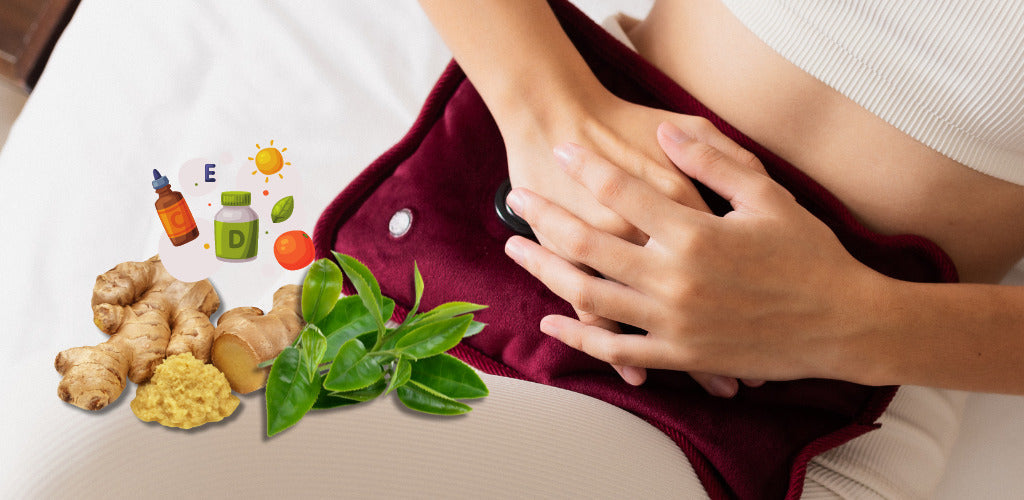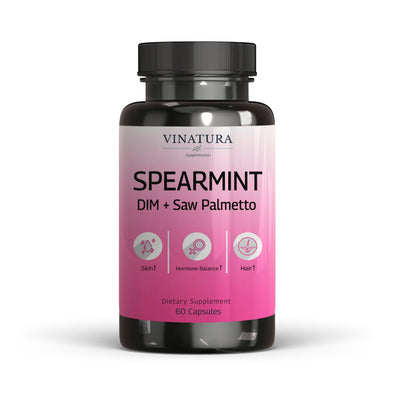
20 Best Supplements For Endometriosis Symptom Relief
When it comes to menstruation, women will have persistent, dull abdominal pain that affects daily activities. This abdominal pain is one of the symptoms of endometriosis. Endometriosis can have adverse effects on a woman's body and can even cause infertility. In this article, we will learn about the 20 best supplements for alleviating symptoms of endometriosis.
Before exploring further, please read the disclaimer located at the end of this webpage.
Key Takeaways
- DIM (Diindolylmethane)
- Curcumin (Turmeric)
- Milk Thistle
- Omega-3s
- Fish Oil Supplements
- Acupuncture
- Chamomile
- Green Tea
- Ginger
- Ashwagandha
- Nattokinase and Serrapeptase
- Probiotics
- Vitamin C
- Vitamin D
- Vitamin Bs & B6
- Alpha-Lipoic Acid
- Epigallocatechin-3-gallate (EGCG)
- Magnesium
- NAC (N-Acetyl Cysteine)
What Is Endometriosis And Its Symptoms?

Endometriosis affects at least 10% of women of reproductive age. It is characterized by the growth of endometrial tissue outside the uterus, causing pelvic pain and affecting fertility. It can even cause infertility [1].
Symptoms of endometriosis include [2]:
- Pelvic pain, especially during menstruation (dysmenorrhea).
- Non-menstrual pelvic pain.
- Pain during intercourse (dyspareunia).
- Painful urination (dysuria) and painful bowel movements (dyschezia).
In a recent survey of about 50,000 women, those with endometriosis often experience heavy, irregular menstrual flow, clotting, and irregular menstrual cycles. Premenstrual spotting is also associated with endometriosis-related infertility. However, most women with this condition still have regular menstrual cycles without abnormal bleeding symptoms [2].
The prevalence of this condition in women of reproductive age is up to 10%, meaning that 1 in 10 women will have it. This is a high and concerning figure for women [3].
Here is a compilation of 20 supplements that can help women alleviate symptoms of endometriosis.
20 Best Supplements for Endometriosis
DIM (Diindolylmethane)

DIM is an antioxidant found in cruciferous vegetables such as cabbage and broccoli. It helps balance estrogen hormone levels in the body, thereby reducing the growth of endometrial tissue.
A study on the combination of DIM and DNG has shown that they can reduce the number of proliferating cells in an experimental model and reduce the production of a hormone called 17β-estradiol, where endometriosis develops. It can also minimize pelvic pain associated with endometriosis and improve bleeding patterns in patients [4].
Curcumin (Turmeric)

Curcumin can reduce inflammation and oxidative stress in endometriosis. It directly affects the invasion, adhesion, apoptosis of cells, and the development of new blood vessels in endometrial lesions [5].
Due to its anti-inflammatory and antioxidant properties, it can help reduce pain and inflammation caused by endometriosis and regulate the body's hormones, slowing the development of endometrial tissue adhesion [5].
Milk Thistle

Silymarin is a natural anti-inflammatory substance found in milk thistle, which can help reduce inflammation and pain associated with endometriosis.
Research has shown that Silymarin reduces the size and severity of endometrial lesions caused in a mouse model. This indicates its potential in alleviating symptoms of endometriosis [6].
Omega-3s

Omega-3s have anti-inflammatory properties and can reduce pain in cases of endometriosis [7]. You can absorb Omega-3s by eating fish such as tuna, salmon, mackerel, fish oil, and various seeds such as flaxseed, chia, sunflower, etc.
Women with endometriosis often lack vitamins A, C, D, and E and omega-3s [8]. Therefore, supplementing Omega-3s can help improve overall health and prevent this condition.
Fish Oil Supplements

A study on 74,708 women has shown that consuming fish oil can improve and reduce pain during menstruation [9]. When you use fish oil, it can provide a rich source of omega-3s, improving inflammation and reducing pain.
Fish oil has also been shown to slow endometrial tissue growth in an animal endometriosis model [10].
You can take fish oil at any time of the day that is convenient for you. However, long-term use of technology is also recommended for the best results.
Acupuncture

In 2017, a study aimed to determine the effectiveness of acupuncture in reducing pain associated with endometriosis. The results of this study demonstrated that acupuncture can help reduce pain associated with endometriosis [11].
However, there are still relatively few studies on this issue. However, many people still choose this method because they believe in its effectiveness.
Three studies with 99 women with endometriosis were found with differences in design, acupuncture technique, and evaluation tools.
However, these studies have in common the use of 7 to 12 needles per session, keeping them for 15-25 minutes and placing them in the lower abdomen/hips, legs, and arms. The treatment frequency ranged from 9 to 16 times in one to two weekly sessions. The results of these studies all showed that it effectively reduced pain in women [12].
Chamomile

Apigenin is a flavone found in chamomile tea. It has various effects, including anti-inflammatory, anti-angiogenic, antioxidant, and anti-proliferative properties. Studies have shown it can prevent inflammation and cell proliferation in endometriosis, making it a potential treatment option [13].
Consuming chamomile tea 2-3 times a day is recommended for maximum benefits. However, be cautious as some people may be allergic to chamomile.
Green Tea

Green tea is rich in antioxidants like catechins, which provide various health benefits, including antioxidant, anti-cancer, and anti-diabetic effects. Studies have shown that green tea has positive effects on reproductive disorders in women, such as endometriosis, polycystic ovary syndrome (PCOS), and dysmenorrhea.
It exhibits anti-angiogenic, anti-fibrotic, and anti-proliferative properties in endometrial tissue, improving ovulation and reducing cyst formation in PCOS while also reducing uterine pain and contractions during dysmenorrhea [14].
Drinking a cup of green tea daily can help women detoxify, boost their spirits and energy, and prevent endometriosis. This is a very simple and effective method worth trying.
Ginger

A study evaluated the effects of ginger extract on endometriosis in Wistar rats. The results showed that consumption of ginger extract reduced the volume of endometrial tissue [15]. This study also showed that the ginger extract group had a lower risk of developing the condition.
Therefore, drinking ginger water when approaching menstruation may help women reduce pain and effectively regulate their cycles. This is also a simple and cost-effective method.
Ashwagandha

Ashwagandha, used in traditional Ayurvedic medicine, has shown promise in addressing infertility issues related to iron overload, a condition associated with endometriosis.
By chelating iron and neutralizing free radicals from iron, Ashwagandha may improve ovarian function and alleviate reproductive issues related to excessive iron accumulation, providing a safer and more cost-effective treatment for endometriosis-related infertility [16].
Ashwagandha supplements come in various forms, such as tablets, powder, liquid, and Ashwagandha tea, allowing you to choose the suitable form.
Nattokinase and Serrapeptase

Natural enzymes found in nattokinase and serrapeptase may help reduce inflammation and pain associated with endometriosis [17], [18]. Both enzymes can significantly reduce the accumulation of certain inflammatory fats, reduce pain and improve blood circulation, thereby alleviating unwanted symptoms of endometriosis.
Nattokinase and serrapeptase are often available in tablet and capsule forms, making them convenient to use and carry anywhere.
Probiotics

Recent studies have shown that probiotic intervention, such as taking Lactobacillus, can help reduce pain and the size of endometrial lesions. Additionally, the imbalance of gut microbiota and endometrial inflammation may be improved through probiotic therapy [19].
Consuming probiotics can balance gut microbiota and improve overall health, reducing harmful bacteria in the body.
Vitamin C

A study to evaluate the effects of vitamin C supplementation on endometriosis showed that using vitamin C and vitamin E significantly reduced oxidative stress markers and the severity of abdominal pain, menstrual cycle, and pain during intercourse [20].
This promising result supports the use of vitamin C to assist in the treatment of endometriosis.
You can schedule regular intake after one or more meals a day. However, ensure not to exceed 1,000mg of vitamin C daily [21]. Exceeding this dosage can have adverse effects on the body.
Vitamin D

Vitamin D can regulate inflammation and the development of endometrial cells [22]. In particular, vitamin D can also reduce pain and endometrial damage.
Salmon is a very rich source of vitamin D. In addition, vitamin D can also be found in foods such as egg yolks, trout, mackerel, mushrooms, seafood, etc. You can easily incorporate vitamin D-rich foods into your daily meals.
Vitamin Bs & B6
Vitamin B, especially pyridoxine (B6), plays a role in estrogen metabolism and promotes the production of anti-inflammatory prostaglandins. These prostaglandins may help inhibit the growth of endometrial tissue [23].
Vitamin B6 is often found in vegetables such as bell peppers, Brussels sprouts, bananas, cauliflower, etc.
Alpha-Lipoic Acid

An effective study of an antioxidant mixture containing N-acetyl cysteine, alpha-lipoic acid, and bromelain to reduce pelvic pain associated with endometriosis. After six months of treatment, pain intensity significantly decreased [24].
The maximum dose of Alpha-Lipoic Acid currently is 1800mg per day [25], make sure you do not exceed this dosage.
Epigallocatechin-3-gallate (EGCG)

Research explores the effectiveness of epigallocatechin-3-gallate (EGCG) in treating fibrosis associated with endometrial tissue. EGCG inhibits the proliferation, migration, and invasion of endometrial stromal and epithelial cells. It also reduces fibrosis signs and prevents progression in animal models [26].
Epigallocatechin gallate is found in green tea, which may also help reduce inflammation and pain associated with endometriosis [26].
Magnesium

Magnesium is important in improving muscle and nerve function, helping reduce tension and pain caused by endometriosis [27].
Some magnesium-rich foods include dark chocolate, avocados, various seeds, tofu, flaxseeds, chia seeds,... However, the recommended dosage of magnesium is about 400 mg [28], so do not over consume too much magnesium.
NAC (N-Acetyl Cysteine)

NAC is an antioxidant and body cleanser that may help reduce inflammation and pain in cases of endometriosis [29]. This is a promising supplement for those with endometriosis.
However, at high doses, it can cause side effects such as nausea, vomiting, diarrhea, and constipation. Moreover, NAC has an unpleasant odor, making it difficult to consume.
Explore Medical Treatment for Endometriosis
In addition to supplementation, consulting with a doctor and healthcare professionals is crucial.
Some medical treatment methods for this condition may include:
- Medication
- Surgery
- Hormone therapy
Conclusion
Nutrition is considered a crucial criterion in effectively treating endometriosis. The use of dietary supplements will help manage the symptoms of endometriosis. The 20 dietary supplements listed in this article have shown promise in reducing inflammation and pain and the size and severity of endometrial lesions in animal models of endometriosis. If you have endometriosis, talk to your doctor before starting any new dietary supplements to ensure they are safe and appropriate for you.
References
- [1] Lebovic, D. I., Mueller, M. D., & Taylor, R. N. (2001). Immunobiology of endometriosis. Fertility and Sterility, 75(1), 1–10. https://doi.org/10.1016/s0015-0282(00)01630-7
- [2] Agarwal, S. K., Chapron, C., Giudice, L. C., Laufer, M. R., Leyland, N., Missmer, S. A., Singh, S. S., & Taylor, H. S. (2019). Clinical diagnosis of endometriosis: a call to action. American Journal of Obstetrics and Gynecology, 220(4), 354.e1–354.e12. https://doi.org/10.1016/j.ajog.2018.12.039
- [3] Eskenazi, B., & Warner, M. L. (1997). EPIDEMIOLOGY OF ENDOMETRIOSIS. Obstetrics and Gynecology Clinics of North America, 24(2), 235–258. https://doi.org/10.1016/s0889-8545(05)70302-8
- [4] Morales-Prieto, D. M., Herrmann, J., Hermann Osterwald, Kochhar, P. S., Ekkehard Schleussner, Markert, U. R., & Oettel, M. (2018). Comparison of dienogest effects upon 3,3′–diindolylmethane supplementation in models of endometriosis and clinical cases. Reproductive Biology, 18(3), 252–258. https://doi.org/10.1016/j.repbio.2018.07.002
- [5] Alexandre Vallée, & Yves Lecarpentier. (2020). Curcumin and Endometriosis. International Journal of Molecular Sciences, 21(7), 2440–2440. https://doi.org/10.3390/ijms21072440
- [6] Sheyda Jouhari, Afsaneh Mohammadzadeh, Haleh Soltanghoraee, Mohammadi, Z., Shaheen Khazali, Ebrahim Mirzadegan, Niknam Lakpour, Fatemi, F., Simin Zafardoust, Arash Mohazzab, & Mohammad Mehdi Naderi. (2018). Effects of silymarin, cabergoline and letrozole on rat model of endometriosis. Taiwanese Journal of Obstetrics and Gynecology, 57(6), 830–835. https://doi.org/10.1016/j.tjog.2018.10.011
- [7] Saffarieh, E., Reyhaneh, S., & Sharami, Y. (2019). A Review on the Management of Endometriosis induced Pain Endometriosis. 13(4). https://pjmhsonline.com/2019/oct_dec/pdf/1057.pdf
- [8] Snyder, S., Sharif, M., & Snyder, G. (2020). International Journal of Women’s Health Care Need-Based Holistic Treatments for Endometriosis in Women Corresponding author. https://www.opastpublishers.com/open-access-articles/needbased-holistic-treatments-for-endometriosis-in-women.pdf
- [9] Signe Østergaard Hansen, & Ulla Breth Knudsen. (2013). Endometriosis, dysmenorrhoea and diet. European Journal of Obstetrics, Gynecology, and Reproductive Biology/European Journal of Obstetrics & Gynecology and Reproductive Biology, 169(2), 162–171. https://doi.org/10.1016/j.ejogrb.2013.03.028
- [10] Xu, Y., Zhao, W., Li, T., Zhao, Y., Bu, H., & Song, S. (2017). Effects of acupuncture for the treatment of endometriosis-related pain: A systematic review and meta-analysis. PloS One, 12(10), e0186616–e0186616. https://doi.org/10.1371/journal.pone.0186616
- [11] Xu, Y., Zhao, W., Li, T., Zhao, Y., Bu, H., & Song, S. (2017). Effects of acupuncture for the treatment of endometriosis-related pain: A systematic review and meta-analysis. PloS One, 12(10), e0186616–e0186616. https://doi.org/10.1371/journal.pone.0186616
- [12] Is acupuncture effective in the treatment of pain in endometriosis? (2016). Journal of Pain Research. https://doi.org/10.2147//JPR.S55580
- [13] Balan, A., Marius Alexandru Moga, Dima, L., Catalina Georgeta Dinu, Carmen Constantina Martinescu, Diana Elena Panait, Claudia Alexandrina Irimie, & Costin Vlad Anastasiu. (2021). An Overview on the Conservative Management of Endometriosis from a Naturopathic Perspective: Phytochemicals and Medicinal Plants. Plants, 10(3), 587–587. https://doi.org/10.3390/plants10030587
- [14] Datu, Norizam Salamt, Mohamad, S., & Mohd Helmy Mokhtar. (2021). Beneficial Effects of Green Tea Catechins on Female Reproductive Disorders: A Review. Molecules/Molecules Online/Molecules Annual, 26(9), 2675–2675. https://doi.org/10.3390/molecules26092675
- [15] Zingiber officinale Roscoe (Ginger) as a Complementary Option for Clinical Treatment of Endometriosis: An Experimental Study in Rats | Journal of Medicinal Food. (2021). Journal of Medicinal Food. https://www.liebertpub.com/doi/abs/10.1089/jmf.2019.0320
- [16] Hardeep Singh Tuli, Joshi, R., Yadav, P., Siddhi Bagwe-Parab, Buttar, H. S., & Kaur, G. (2023). Iron Chelation and Antioxidant Properties of Withania somnifera (Ashwagandha) Restore Fertility in Men and Women. Current Bioactive Compounds, 19(7). https://doi.org/10.2174/1573407219666230210101925
- [17] Nicholas Dr. Calvino. (2002). The enzyme of enzymes. Townsend Letter for Doctors and Patients, 232, 90–94. https://go.gale.com/ps/i.do?id=GALE%7CA93736416&sid=googleScholar&v=2.1&it=r&linkaccess=abs&issn=15254283&p=AONE&sw=w&userGroupName=anon%7E6cb77661&aty=open-web-entry
- [18] Howenstine, J. A. (2006). How systemic enzymes work to cure diseases. Original Internist, 13(4), 196–204. https://go.gale.com/ps/i.do?id=GALE%7CA159080144&sid=googleScholar&v=2.1&it=r&linkaccess=abs&issn=15294722&p=HRCA&sw=w&userGroupName=anon%7Edb2af331&aty=open-web-entry
- [19] Jiang, I., Yong, P. J., Allaire, C., & Bedaiwy, M. A. (2021). Intricate Connections between the Microbiota and Endometriosis. International Journal of Molecular Sciences, 22(11), 5644–5644. https://doi.org/10.3390/ijms22115644
- [20] Amini, L., Razieh Chekini, Mohammad Reza Nateghi, Haghani, H., Tannaz Jamialahmadi, Thozhukat Sathyapalan, & Amirhossein Sahebkar. (2021). The Effect of Combined Vitamin C and Vitamin E Supplementation on Oxidative Stress Markers in Women with Endometriosis: A Randomized, Triple-Blind Placebo-Controlled Clinical Trial. Pain Research & Management, 2021, 1–6. https://doi.org/10.1155/2021/5529741
- [21] Levine, M. (1999). Criteria and Recommendations for Vitamin C Intake. JAMA, 281(15), 1415–1415. https://doi.org/10.1001/jama.281.15.1415
- [22] Pierluigi Giampaolino, Luigi Della Corte, Foreste, V., & Bifulco, G. (2019). Is there a Relationship Between Vitamin D and Endometriosis? An Overview of the Literature. Current Pharmaceutical Design, 25(22), 2421–2427. https://doi.org/10.2174/1381612825666190722095401
- [23] Ghazal Roshanzadeh, Shahideh Jahanian Sadatmahalleh, Moini, A., Azadeh Mottaghi, & Rostami, F. (2023). The relationship between dietary micronutrients and endometriosis: A case-control study. International Journal of Reproductive Biomedicine. https://doi.org/10.18502/ijrm.v21i4.13272
- [24] Lete, I., Mendoza, N., Esther, & Carmona, F. (2018). Effectiveness of an antioxidant preparation with N-acetyl cysteine, alpha lipoic acid and bromelain in the treatment of endometriosis-associated pelvic pain: LEAP study. European Journal of Obstetrics, Gynecology, and Reproductive Biology/European Journal of Obstetrics & Gynecology and Reproductive Biology, 228, 221–224. https://doi.org/10.1016/j.ejogrb.2018.07.002
- [25] Eun Hee Koh, Woo Je Lee, Sang Ah Lee, Eun Hee Kim, Eun Hee Cho, Jeong, E., Dong Woo Kim, Kim, M.-S., Park, J.-Y., Park, K.-G., Lee, H.-J., Lee, I.-K., Lim, S., Hak Chul Jang, Ki Hoon Lee, & Lee, K.-U. (2011). Effects of Alpha-Lipoic Acid on Body Weight in Obese Subjects. the American Journal of Medicine, 124(1), 85.e1–85.e8. https://doi.org/10.1016/j.amjmed.2010.08.005
- [26] Matsuzaki, S., & Darcha, C. (2014). Antifibrotic properties of epigallocatechin-3-gallate in endometriosis. Human Reproduction, 29(8), 1677–1687. https://doi.org/10.1093/humrep/deu123
- [27] Harris, H. R., Chavarro, J. E., Malspeis, S., Willett, W. C., & Missmer, S. A. (2013). Dairy-Food, Calcium, Magnesium, and Vitamin D Intake and Endometriosis: A Prospective Cohort Study. American Journal of Epidemiology, 177(5), 420–430. https://doi.org/10.1093/aje/kws247
- [28] Kass, L., Weekes, J., & Carpenter, L. (2012). Effect of magnesium supplementation on blood pressure: a meta-analysis. European Journal of Clinical Nutrition, 66(4), 411–418. https://doi.org/10.1038/ejcn.2012.4
- [29] Chiara Agostinis, Zorzet, S., R. De Leo, Giorgio Zauli, F. De Seta, & Bulla, R. (2015). The Combination of N-Acetyl Cysteine, Alpha-Lipoic Acid, and Bromelain Shows High Anti-Inflammatory Properties in NovelIn VivoandIn VitroModels of Endometriosis. Mediators of Inflammation, 2015, 1–9. https://doi.org/10.1155/2015/918089
Author

Product Disclaimer
Including an ingredient or study does not evaluate, endorse, or recommend any Vinatura product or any third-party product. Some ingredients discussed may not be used in any Vinatura product.
The content of the articles has not been evaluated by the Food and Drug Administration (FDA) and is not intended to promote or endorse any specific product. Any products sold on this website are not intended to diagnose, treat, cure, or prevent any disease.
Opinions and Endorsements
Any claims, statements, or opinions expressed in the articles are those of the author(s) and do not necessarily reflect the views or opinions of the manufacturers of the dietary supplement products. The products sold on this website are separate from the content of the articles and are not directly endorsed or associated with the information presented here.
Liability Disclaimer
The author(s) of the articles, website, and manufacturers of the dietary supplement products do not assume any liability for any potential consequences arising from the use of the information provided in the articles. Ingredient effects, dosages, and safety vary by individual, formulation, and context; some ingredients interact with medications or may be unsuitable during pregnancy or lactation. It is recommended that individuals consult with a qualified healthcare professional before making any dietary or lifestyle changes, including the use of dietary supplements.
Product Usage
Please refer to the product labels and packaging for specific usage instructions and guidelines for the dietary supplement products sold on this website.
Customer Support
For any concerns or questions regarding the dietary supplement products, please contact our customer support team, who will be more than happy to assist you.





Leave a Comment
Be the first to comment.
What do you think?